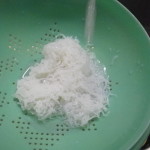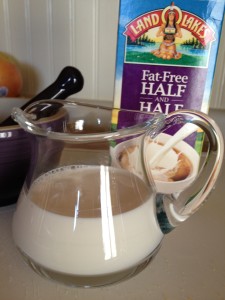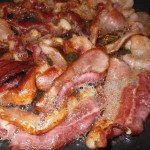
We recently had house guests and served bacon for breakfast. The husband got all excited, saying “Wow, real bacon, my wife only allows me to have turkey bacon.” I, personally, had never considered switching to turkey bacon; I’ve always thought that some folks switch to turkey products falsely thinking they are eating more healthful. But this got me thinking and wondering.
So, I bought two packages of bacon. One turkey and one pork. At first glance they look similar. But under closer scrutiny the first obvious difference is the turkey bacon was a 12 ounce package. The number of slices differed, too. You got 15 slices in the 16-ounces of pork and 22 slices in the 12-ounces of turkey. So, obviously, the weights of the slices were smaller in the turkey bacon. All of this makes in-store comparison difficult.
Compare the Nutrition Facts labels for serving sizes:
- The pork bacon lists serving sizes as 2 slices (I guess they are being practical that no one could eat just one.)
- The turkey bacon identifies serving size as 1 slice.
So, let’s compare them slice-to-slice.
Pork Turkey
Calories: 40 35
Total fat: 3.5 grams 3 grams
Saturated fat: 1.25 grams 1 gram
Cholesterol: 10 mg 15 mg
Protein 2.5 grams 2 grams
Sodium 150 mg 180 mg
The turkey bacon label promotes that their bacon “gives you all the great bacon taste you want with 50% less fat.” The package says they used the USDA nutrition data for pork bacon to come up with that statement. But the math from the two packages I compared just didn’t show that.
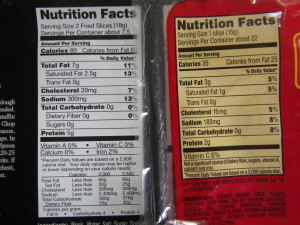
They also list 6% Daily Value of Vitamin C in the turkey bacon. I don’t usually think about bacon as a source of vitamin C so I called the company. They responded that the Vitamin C comes from the soy. The last item on the ingredient list is soy lecithin.
I then cooked them and compared the products.
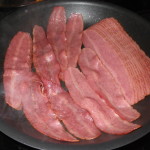
The cooked weight of the pork bacon was 4.2 ounces and the turkey bacon was 6.25 ounces. So there was obviously less loss of fat and moisture in the turkey product. It’s important to note that the turkey bacon was completely pre-cooked. After cooking there was ½ cup of fat that could be drained from the pork bacon. There was very little fat in the pan where the turkey bacon was cooked.
Comparing the final cooked product: you got lots more turkey bacon on the plate (see photo). The turkey slices didn’t shrink as much. The turkey bacon is “smoked cured turkey chopped and formed”. That was very obvious in the texture. It’s hard to describe, but I guess the best way is that it was “chewier”. This isn’t noticeable when the bacon is added to a sandwich or eaten combined with other foods, but just on a plate for breakfast, this chewy texture was obvious.
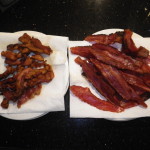
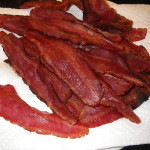
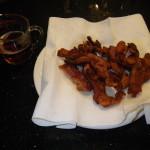
So, what’s my overall thought as a result of this comparison?
- The overall fat, calories and sodium are very comparable. Although the turkey product is slightly lower in fat and calories than the pork it is slightly higher in sodium.
- Flavor and texture-wise I guess I’d vote for the pork bacon.
- If you’re comparing price, you get more cooked edible product for the money in the turkey bacon.
Bacon (pork or turkey) is really one of those products generally thought of as an “occasional” food. There is very little “good nutrition” in any kind of bacon. But, most people like it now and again for the flavor and you can’t beat a BLT sandwich.
But, you can get a lot of flavor from perhaps a little less bacon. Maybe go for 2 slices instead of 3 and then only every so often (like when you have special guests for breakfast.) A small amount of bacon chopped could go a long way to add flavor to a recipe.
They may also be other companies that make different bacon products that might actually give you a little less sodium or little less saturated fat than those I purchased. You’ll need to do your own nutrition comparisons. Both products also are considered “processed meats” and do contain nitrates and other preservatives that might be contraindicated in some diets.
But overall I don’t think “whole hog” switching to turkey bacon is doing you any favors nutritionally.
My problem now: What do I do with all this cooked bacon?
Cheryle Jones Syracuse, MS
Professor Emeritus,
The Ohio State University



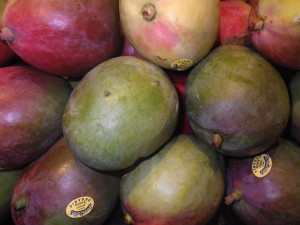 After the
After the 